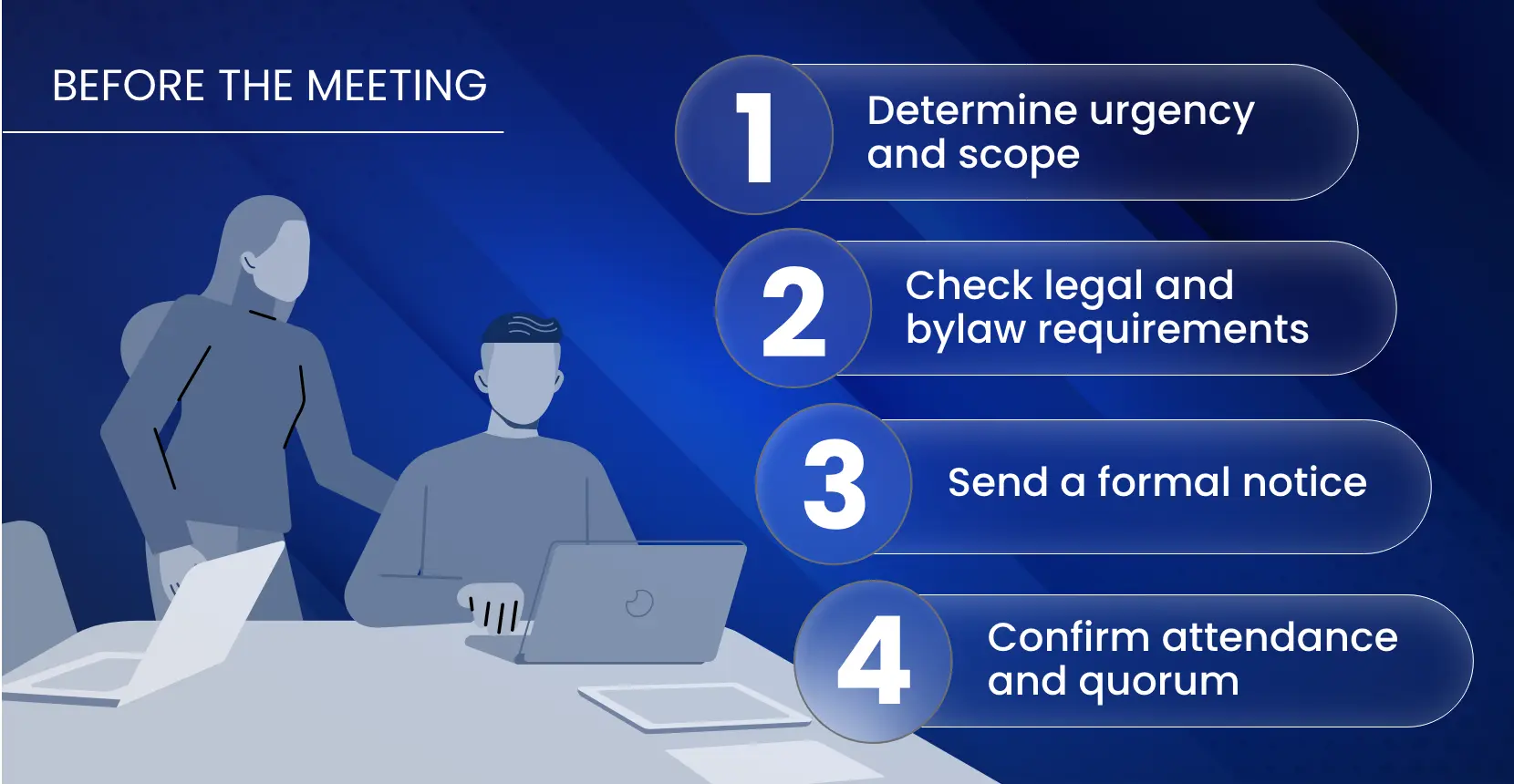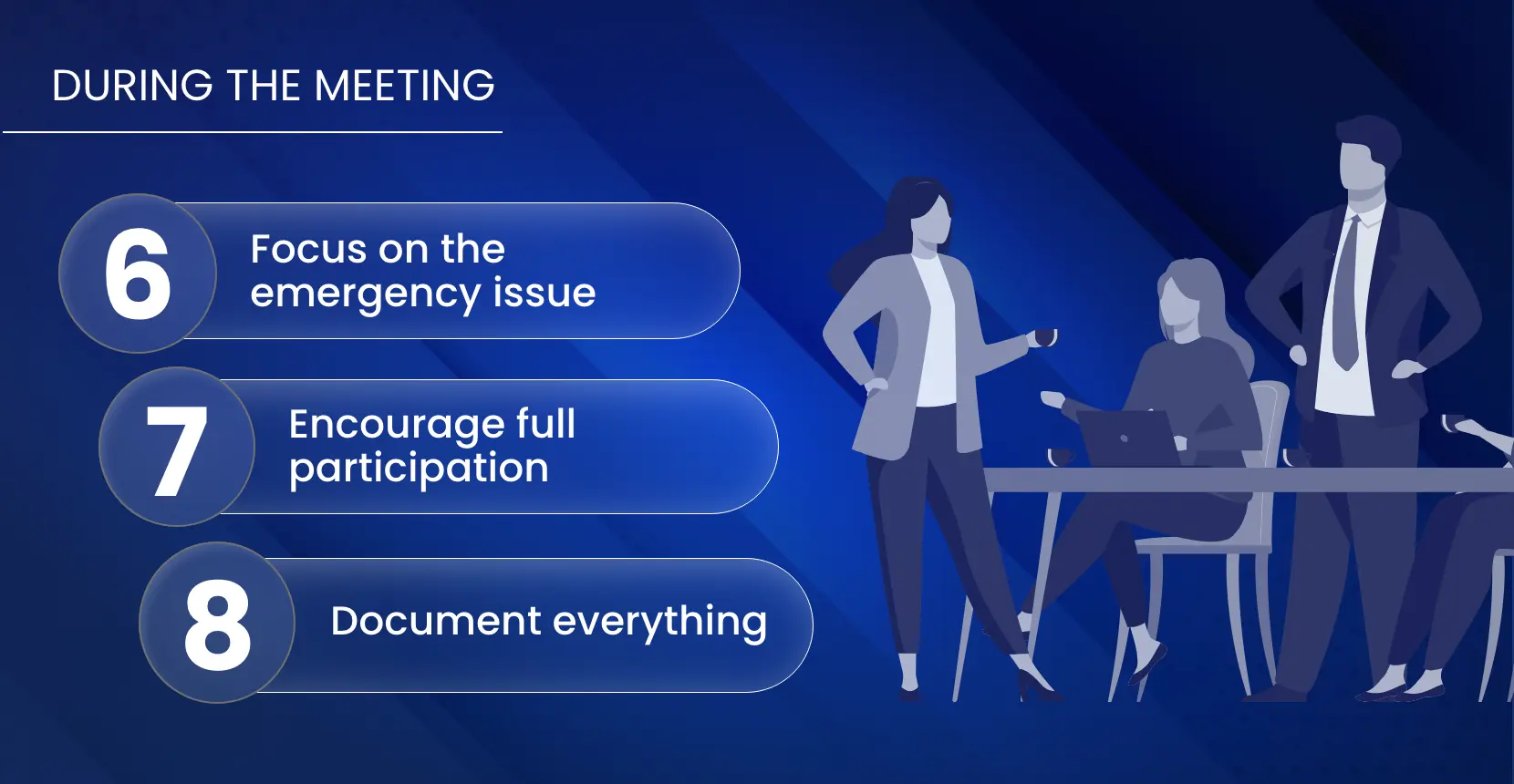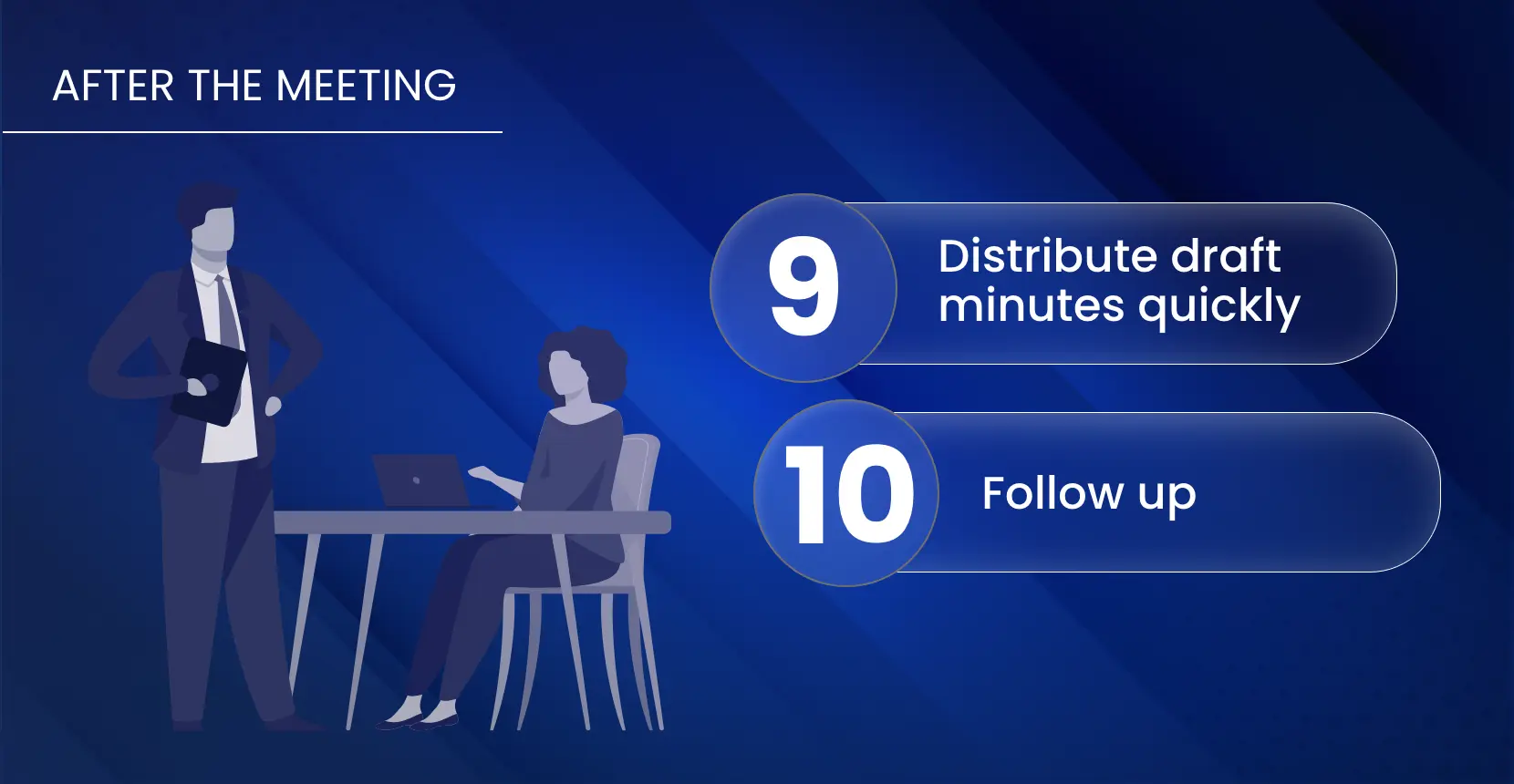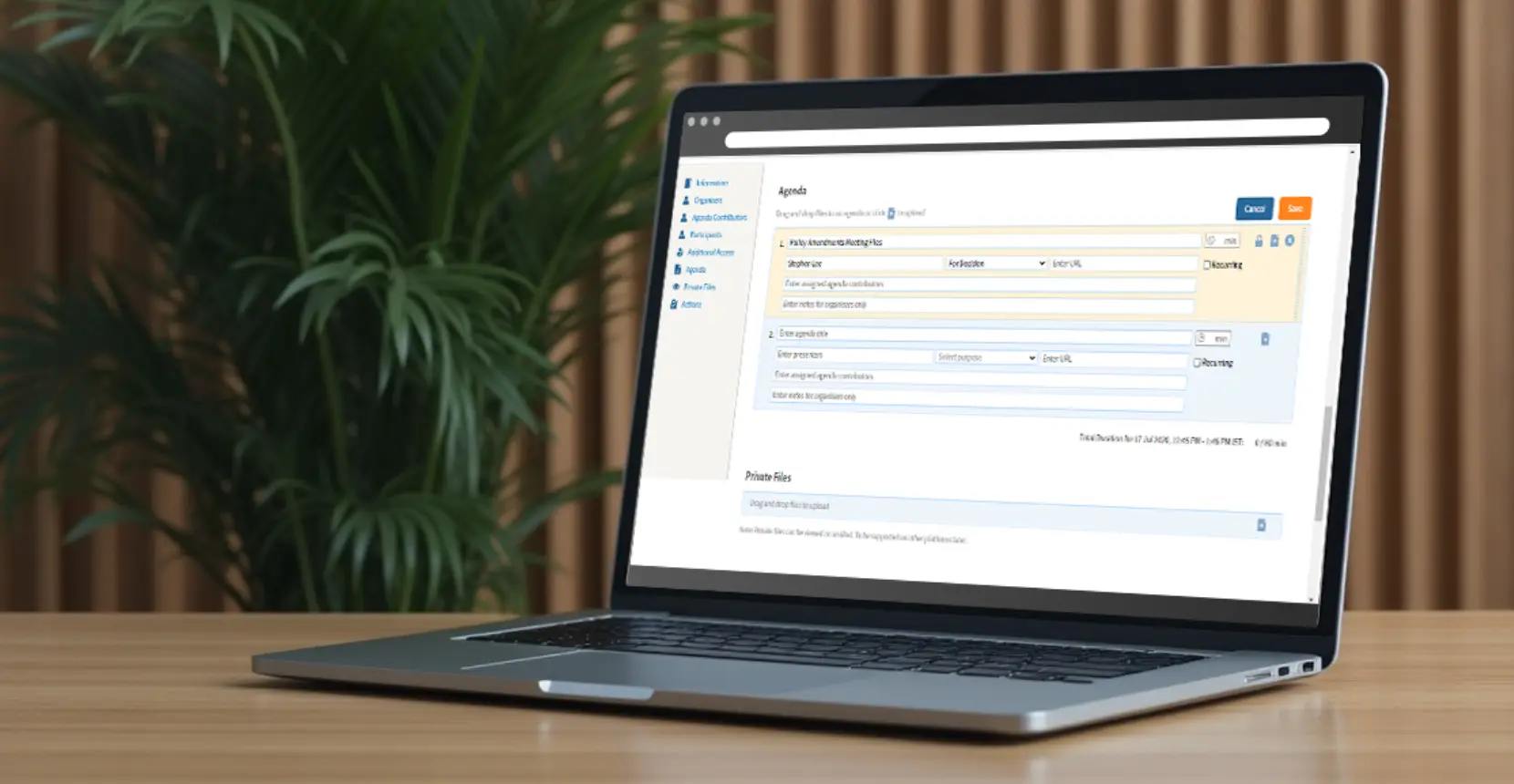No matter how big your organization is or how prepared you think you are, no one is immune to emergencies — and when one happens, your board cannot afford to wait for the next scheduled meeting to decide what to do. Whether it is a data breach or a major acquisition opportunity, every minute that passes without a clear and immediate action could cost you millions in losses. Boards must therefore act swiftly by calling an emergency board meeting as soon as possible.
But what exactly is an emergency board meeting? How does it differ from a regular meeting? In this guide, you will learn everything you need to know about this type of meeting, including its benefits, rules, best practices, and how to call a meeting. Plus, access our free emergency board meeting agenda template to get you started.
What is an emergency board meeting?
An emergency board meeting, as the term suggests, is an unscheduled gathering of a company’s board of directors brought about by internal or external emergencies. These gatherings are often called and authorized by the chairman or president of the board (alternatively, by any two directors, excluding the president). During this special type of meeting, the board limits discussion to the immediate issue that could threaten the organization’s operations, financial health, or legal standing. This means that there is no time for any other business. Ideally, they must arrive at a decision on the same day as well.
Because these matters are time-sensitive, emergency meetings are usually convened and voted upon as soon as the emergency arises, allowing for a shorter board meeting notice. For reference, here are some common scenarios that are deemed an emergency:
- Sudden departure of key executives, particularly the CEO
- Financial and legal issues
- Cybersecurity attacks
- Natural disasters affecting business operations
- Unexpected acquisition opportunities
- Product recalls or safety issues
- Major public relations crises
Emergency Board Meetings vs. Regular Board Meetings
While legal requirements and voting rules still apply, emergency meeting processes are streamlined for speed. More importantly, the meeting agenda stays tightly focused on the urgent matter, which leaves no room for unrelated discussion. To give you a clearer picture of how it differs from a regularly scheduled board meeting, here is a comparison table:
| Regular Meetings | Emergency Board Meetings | |
| Notice Requirements | 10-30 day advance notice, depending on corporate bylaws, methodically scheduled | 24-48 hour notice |
| Scope of Agenda | Routine business check-up and committee reports, often pre-determined | Focused on the urgent matter at hand only |
| Attendance | Board members are expected to attend in person, unless travel is impractical | Remote participation is more acceptable given the short notice |
| Decision Authority | Full discussion, all major decisions expected to be considered | Minimal deliberation, only certain emergency decisions can be made |
Why call an emergency board meeting?
An emergency meeting serves as the first-aid solution during a crisis. Instead of waiting for help to arrive — in this case, the regularly scheduled board meeting — this special type of meeting allows boards to act quickly and make time-sensitive decisions, and ultimately avoid downtime. They provide significant advantages for organizations facing urgent situations, such as:
Rapidly make decisions and manage crises
Time is of the essence when it comes to emergencies. These meetings, then, let the board retain some level of control over the issues before they blow up. This speed helps contain damage and resolve problems as early as possible. In fact, a 2024 research from BCI shows that 75% of organizations had to activate their crisis management plans over the past year (2023), underscoring how common urgent decisions have become.
Establish clear authority and responsibility
In these types of scenarios, the last thing to worry about is grasping for who can make decisions, who must be consulted, and whose vote or consent is required. This would be a non-issue with a well-planned emergency procedure, clearly defining which executives or directors have the power to act. Clear assignment of roles and responsibilities ensures there’s no confusion or delay in action. As research on community banks reveals, when financial distress hits, regularly scheduled meetings tend to decrease while impromptu, unplanned gatherings rise. Boards, in turn, are able to shift their focus to urgent issues such as capital and regulatory oversight, often setting aside routine formalities to deal with immediate threats.
Ensure legal protection and due diligence
Organizations are often under strict regulations when it comes to their meeting and governance processes. During a crisis, this scrutiny doubles. Emergency board meetings, when called and conducted according to the organization’s bylaws and relevant laws, can help protect the organization. Following proper emergency board meeting notice, record-keeping, and voting rules ensures that decisions are valid and defensible, reducing legal liabilities if it ever comes down to litigation.
How to Call an Emergency Board Meeting: A Step-by-Step Guide
The Robert’s Rules of Order are usually used to run board meetings. This means that there is a standard approach in discussion, and every participant has the same rights and responsibilities. But in most cases, companies can change their methods to fit their demands and the bylaws of the company. Here are the steps you should take before, during, and after an emergency board meeting to make sure it goes well:
Before the meeting

Step 1: Determine urgency and scope
First and foremost, you need to figure out what the emergency is and make it obvious why the problem cannot wait until the next board meeting. Write down that the issue is urgent and make sure it is something that the board needs to deal with. This paperwork will be very important for taking notes at meetings and for any possible legal review in the future.
Step 2: Check legal and bylaw requirements
It’s best to have this taken care of ahead of time. If not, check the laws and company bylaws that apply to you for:
- Minimum notice periods (usually 24 to 48 hours);
- Requirements for a quorum; and
- Requirements for filing and documentation, among other things.
Ideally, boards should also develop emergency meeting protocols that align with company bylaws, outlining notice procedures, communication channels, and role assignments to avoid confusion in high-pressure situations. A board portal like Convene can help centralize these rules and templates, so directors can easily and safely access them when time is critical.
Step 3: Send a formal notice
Even though it’s urgent, sending a formal written notice to the members is required. The emergency meeting notice should contain:
- Clear statement that it is an emergency meeting
- Date, time, and place (including specifics for virtual meetings, if there are any)
- Specific cause for the emergency meeting
- Short list of topics or agenda for discussion
- Any documents or resources that need to be read beforehand
Step 4: Confirm attendance and quorum
Get in touch with each director to make sure they will be there and that you will have the right number of people present in the meeting. If you can’t get a quorum, you might have to:
- Think about other ways to obtain approvals, such as written consent procedures,
- Or look at the emergency authorities that the executive committees have.
During the meeting

Step 6: Focus on the emergency issue
Resist the temptation to address unrelated business matters. If the conversation starts to go off track, gently steer it back to the primary point and remind everyone why this issue needs to be dealt with right away. Keeping everyone on the same page makes sure the meeting stays focused on action and getting things done.
Step 7: Encourage full participation
Make sure every director has the opportunity to ask questions and share their perspectives, even if the meeting timeframe is limited. Active participation can uncover important insights, prevent misunderstandings, and build consensus on the best course of action. Covering all key decision points is essential, and techniques like a brief round-robin or prompting quieter members can help ensure no viewpoint is overlooked.
Step 8: Document everything
Write down everything that was said, decided, and why each action was taken in great detail. Meeting minutes are formal records that can be used to plan future actions and make sure that all legal and business obligations are met. The board president should designate someone, often the board secretary, to record the key points, action items, and next steps, so the board has a clear, accurate record to guide follow-up and accountability.
After the meeting

Step 9: Distribute draft minutes quickly
Share draft minutes within 24-48 hours while the discussion is still fresh in everyone’s mind. Quick distribution helps make sure everything is correct and gives directors a chance to explain anything they need to. Above all, it backs putting approved choices into action right away.
Step 10: Follow up
Set up the necessary communications with workers, outside parties, and stakeholders to keep everyone up to date and on the same page. Consider whether additional follow-up meetings are needed to monitor the situation or make further decisions. Timely follow-up makes sure that people are held accountable and helps the company adapt to evolving situations.
Emergency Board Meeting Agenda Template
Here’s a practical template you can customize for your organization’s emergency board meetings:
EMERGENCY BOARD MEETING AGENDA
Company Name:
I. Call to Order and Roll Call (5 minutes)
II. Executive Session (10 minutes)
III. Presentation of Emergency Matter (15 minutes)
IV. Expert Advisor Input (15 minutes)
V. Board Discussion and Questions (20 minutes)
VI. Decision and Action Items (10 minutes) Formal resolutions and voting VII. Next Steps and Follow-Up (10 minutes)
VIII. Adjournment |
Frequently Asked Questions on Emergency Board Meetings
How much notice is legally required for an emergency board meeting?
The amount of notice needed varies by jurisdiction and corporate bylaws, but it usually falls between 24 and 48 hours. Some places let you give less notice for real emergencies. Always check your company’s bylaws and any state or local laws that apply.
Is it possible to hold emergency meetings online?
Most modern corporate bylaws and state laws allow virtual emergency meetings, especially since COVID. Make sure that your technology platform has the right level of security and recording features for proper documentation.
How do you ensure decisions in emergency meetings are not made emotionally?
This is where emergency meeting protocols make the difference. Sticking to the agenda, consulting subject-matter experts, and documenting discussions helps boards stay objective and avoid hasty, emotion-driven choices.
What are emergency board actions?
Board actions are decisions the board takes outside of its regular schedule to address urgent issues, such as approving immediate financing or authorizing crisis management measures. They are usually documented separately to ensure compliance and accountability.
Streamline Meetings and Decisions with Convene Board Portal
Emergency board meetings, like any other type of meeting, require preparation, clear processes, and the right modern tools to successfully govern. While emails, virtual meeting platforms, and other collaboration tools work just fine, the leading board meeting software, Convene, integrates everything into one portal and helps boards manage every stage efficiently, even on short notice.

With the Convene board portal, you can:
- Pre-Meeting: Store, review, and annotate documents; build agendas quickly; automate meeting pack distribution.
- During Meeting: Collaborate via integrated secure video conferencing feature; boost participation with live tools; record notes digitally.
- Post-Meeting: Track action items instantly; sign documents electronically; review minutes in one place.
What’s more, Convene’s newest artificial intelligence feature, Convene AI, makes meetings smarter and more efficient with automated meeting summaries and decision highlights.
Take a look at your current meeting process. Are your current meetings streamlined, secure, and easy to manage? If you think it doesn’t work the way you want it to, maybe it’s time for a switch. Drop us a call today to schedule a one-on-one product demo.
Jess is a Content Marketing Writer at Convene who commits herself to creating relevant, easy-to-digest, and SEO-friendly content. Before writing articles on governance and board management, she worked as a creative copywriter for a paint company, where she developed a keen eye for detail and a passion for making complex information accessible and enjoyable for readers. In her free time, she’s absorbed in the most random things. Her recent obsession is watching gardening videos for hours and dreaming of someday having her own kitchen garden.











